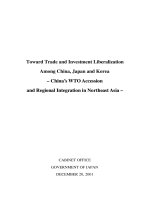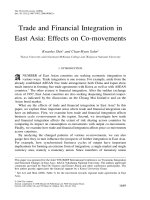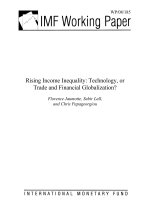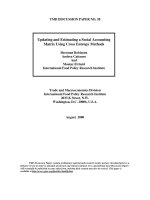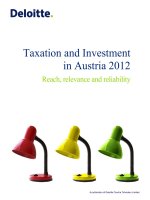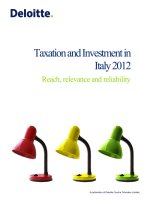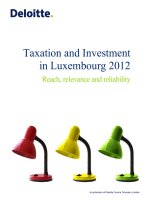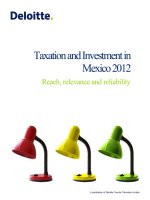Greening trade and investment environmental protection without protectionism
Bạn đang xem bản rút gọn của tài liệu. Xem và tải ngay bản đầy đủ của tài liệu tại đây (1.38 MB, 241 trang )
Greening Trade 19/4
8/5/01
12:41 pm
Page i
Greening Trade and Investment
Environmental Protection Without Protectionism
Eric Neumayer
Greening Trade 19/4
8/5/01
12:41 pm
Page ii
For my parents, in gratitude
First published by Earthscan in the UK and USA in 2001
For a full list of Earthscan publications please contact:
Earthscan
2 Park Square, Milton Park, Abingdon, Oxon OX14 4RN
711 Third Avenue, New York, NY, 10017, USA
Earthscan is an imprint of the Taylor & Francis Group, an informa business
Copyright © Eric Neumayer, 2001. Published by Taylor & Francis.
All rights reserved. No part of this book may be reprinted or reproduced or utilised in
any form or by any electronic, mechanical, or other means, now known or hereafter
invented, including photocopying and recording, or in any information storage or retrieval
system, without permission in writing from the publishers.
Notices:
Practitioners and researchers must always rely on their own experience and knowledge in
evaluating and using any information, methods, compounds, or experiments described herein.
In using such information or methods they should be mindful of their own safety and the
safety of others, including parties for whom they have a professional responsibility.
Product or corporate names may be trademarks or registered trademarks, and are used only
for identification and explanation without intent to infringe.
A catalogue record for this book is available from the British Library
Library of Congress Cataloging-in-Publication Data
Neumayer, Eric, 1970Greening trade and investment : environmental protection without
protectionism / Eric Neumayer.
p. cm.
Includes bibliographical references and index.
ISBN 1-85383-787-3 – ISBN 1-85383-788-1 (pbk.)
1. Free trade–Environmental aspects. 2. Investments, Foreign–Environmental
aspects. 3. Environmental policy–Economic aspects. 4. Environmental
policy–Developing countries. 5. Environmental protection–Developing countries.
6. World Trade Organization–Developing countries. I. Title.
HF1713.N42 2001
333.7–dc21
ISBN-13: 978-1-853-83787-6 (hbk)
ISBN-13: 978-1-853-83788-3 (pbk)
Typesetting by PCS Mapping & DTP
Cover design by Richard Reid
2001001379
Greening Trade 19/4
8/5/01
12:41 pm
Page iii
Contents
List of Tables and Boxes
Preface
List of Acronyms and Abbreviations
Introduction
iv
v
vi
viii
Part One: Foundations
1
2
Globalization: Investment, Trade and the Environment in an
Integrating World Economy
The Current Multilateral Trade and Investment Regimes
3
21
Part Two: Investment
3
4
5
6
Pollution Havens: Do Developing Countries Set Inefficient
Environmental Standards to Attract Foreign Investment?
Regulatory Chill: Do Developed Countries Fail to Raise
Environmental Standards Because of Feared Capital Flight?
Roll-back: Do Foreign Investors Use Investor-to-State Dispute
Settlement to Knock Down Environmental Regulations?
A Case Study: The Failed Attempt to Conclude a Multilateral
Agreement on Investment
41
68
79
91
Part Three: Trade
7
8
9
Trade Liberalization and the Environment
GATT/WTO Dispute Settlement and the Environment
WTO Rules and Multilateral Environmental Agreements
103
118
158
10 Conclusion and Summary of Policy Recommendations
185
Appendix: Environmental Provisions in Regional and Bilateral
Trade and Investment Agreements
Notes
References
Index
190
194
202
223
Greening Trade 19/4
8/5/01
12:41 pm
Page iv
List of Tables and Boxes
Tables
1.1 Ratios of merchandise trade to GDP in per cent
1.2 Ratios of merchandise trade to merchandise value-added in
per cent
3.1 Developing countries’ environmental standards relative to
developed countries’ standards under efficiency conditions
3.2 Developing countries’ environmental standards relative to
developed countries’ standards under non-efficiency conditions
3.3 Evaluation of policy options addressing the ‘pollution haven’
problem
4.1 Evaluation of policy options addressing the ‘regulatory chill’
problem
10.1 Summary of policy recommendations
A.1 Overview of environmental provisions in regional and bilateral
agreements
5
7
50
51
66
78
186
192
Box
2.1 Eco-labelling schemes and WTO rules
27
Greening Trade 19/4
8/5/01
12:41 pm
Page v
Preface
Foreign investment and international trade are regarded with great suspicion
by some environmentalists. They fear that a free flow of capital and goods
and services might significantly harm the environment. Consequently, they
demand that the multilateral investment and trade regimes should allow
nation states to intervene for the protection of the environment.
Representatives from developing countries in turn regard these demands
with great suspicion. They fear that the developed countries will use strong
interventionist rights to their own advantage and to the detriment of developing countries. Consequently, they oppose most, if not all, demands for a
‘greening’ of the multilateral investment and trade regimes.
As someone who cares about the environment, believes in the merits of a
liberal investment and trade regime, and is sympathetic to the concerns of
developing countries’ representatives, it was no easy task to write this book
on investment, trade and the environment. I have tried to show ways in which
the multilateral investment and trade regimes could be made more environmentally friendly without unnecessarily restricting the free flow of capital and
goods and services, and without detriment to the economic development
aspirations of developing countries. Winning developing countries’ support is
the greatest challenge ahead for a successful greening of the multilateral
investment and trade regimes – a challenge that this book tries to meet.
I hope that I have written a book that is accessible to many people without
prior specialist knowledge in the issues. However, this book would not have
been possible without the help of many. It has benefited much from constructive comments from others. My special thanks go to Duncan Brack from the
Royal Institute of International Affairs in London, Dan Esty from the Yale
Center for Environmental Law and Policy, Jonathan Krueger from the John F
Kennedy School of Government at Harvard University, David Pearce from
University College London, Nick Mabey from WWF, Tim Forsyth, Gilles
Duranton and Simon Batterbury from the London School of Economics and
Political Science, as well as several anonymous referees. Thanks for their
support also go to Jagdish Bhagwati, Vudayagi Balasubramanyam, Steve
Charnovitz and Aaron Cosbey, and finally to the Earthscan team. All errors
are mine, as are all the views expressed in this book.
Shorter and revised versions of various parts of this book have been
previously published in journals. My thanks go to the editors of these
journals for their willingness to accept publication of these articles.1
Dr Eric Neumayer
London School of Economics and Political Science
London, March 2001
Greening Trade 19/4
8/5/01
12:41 pm
Page vi
List of Acronyms and Abbreviations
AEA
AFL-CIO
American Electronics Association
American Federation of Labor-Congress of Industrial
Organizations
AFTA
ASEAN Free Trade Area
APEC
Asia-Pacific Economic Cooperation
ASEAN
Association of Southeast Asian Nations
BDI
Bundesverband der Deutschen Industrie
BIT
Bilateral Investment Treaty
BSE
bovine spongiform encephalopathy
BTA
border tax adjustment
BTU
British Thermal Unit
CAFE
corporate average fuel economy
CARICOM Caribbean Community
CBD
Convention on Biological Diversity
CEC
Commission for Environmental Cooperation
CEPA
Canadian Environmental Protection Act
CFC
chlorofluorocarbon
CITES
Convention on International Trade in Endangered Species of
Wild Fauna and Flora
CO
carbon monoxide
carbon dioxide
CO2
COMESA Common Market for Eastern and Southern Africa
CTE
Committee on Trade and Environment
DDT
dichlorodiphenyltrichloroethane
DSB
dispute settlement body
DSU
dispute settlement understanding
EC
European Communities
EC
European Community
EFTA
European Free Trade Association
EKC
Environmental Kuznets Curve
EPA
Environmental Protection Agency
EU
European Union
FDI
foreign direct investment
FTAA
Free Trade Area of the Americas
GATS
General Agreement on Trade in Services
GATT
General Agreement on Tariffs and Trade
GCC
Global Climate Change Coalition
GDP
gross domestic product
GMO
genetically modified organism
Greening Trade 19/4
8/5/01
12:41 pm
Page vii
List of Acronyms and Abbreviations
GNP
HCFC
IBRD
ICC
ICSID
IDCP
IISD
IMF
ITO
IUCN
LCA
MAI
MEA
Mercosur
MMPA
MMT
MTBE
NAAEC
NAFTA
NGO
NO2
NOx
ODA
ODS
OECD
PCB
PIC
POP
PPM
SADC
SME
SO2
SOx
SPS
TBT
TED
TNC
TREM
TRIM
TRIP
UN
UNCED
UNCLOS
UNCTAD
UNEP
UPOV
US
WEO
WTO
WWF
vii
gross national product
hydrochlorofluorocarbon
International Bank for Reconstruction and Development
International Chamber of Commerce
International Center for the Settlement of Investment Disputes
International Dolphin Conservation Programme
International Institute for Sustainable Development
International Monetary Fund
International Trade Organization
World Conservation Union (formerly International Union for
Conservation of Nature and Natural Resources)
life-cycle analysis
Multilateral Agreement on Investment
Multilateral Environmental Agreement
Mercado Común del Sur
Marine Mammal Protection Act
methylcyclopentadienyl manganese tricarbonyl
methyl tertiary butyl ether
North American Agreement on Environmental Cooperation
North American Free Trade Agreement
non-governmental organization
nitrogen dioxide
nitrogen oxides
official development assistance
ozone-depleting substance
Organization for Economic Co-operation and Development
polychlorinated biphenyl
Prior Informed Consent
persistent organic pollutant
process and production method
Southern African Development Community
small and medium enterprise
sulphur dioxide
sulphur oxides
sanitary and phytosanitary
Technical Barriers to Trade
turtle excluder device
transnational corporation
Trade-Related Environmental Measure
Trade-Related Investment Measure
Trade-Related Intellectual Property Right
United Nations
United Nations Conference on Environment and Development
United Nations Convention on the Law of the Sea
United Nations Conference on Trade and Development
United Nations Environment Programme
Union for the Protection of New Varieties of Plants
United States
World Environment Organization
World Trade Organization
formerly known as World Wide Fund For Nature
Greening Trade 19/4
8/5/01
12:41 pm
Page viii
Introduction
At the start of a new millennium, humankind finds itself confronted with
many challenges, one of which is to find a solution to the environmental
problems that are manifold both within nation states and internationally.
Developing countries in particular are faced with severe environmental
problems that directly affect human health and welfare: restricted access to
clean drinking water and sanitation; heavy air and water pollution; erosion
and destruction of local renewable resources, to mention just a few. The
problem of global ozone depletion has more or less been resolved through
successive international agreements but the community of nation states is
only beginning to formulate an adequate response to international and global
environmental problems such as climate change, biodiversity loss and toxic
pollutants.
Greening Trade and Investment examines how this environmental
challenge is affected by a phenomenon commonly referred to as ‘globalization’. The term describes the fact that countries are increasingly linked with
each other via foreign investment and international flows of trade. Many
environmentalists and academics alike fear that globalization will affect the
environment negatively and will render a successful meeting of the environmental challenge more difficult, if not impossible (Daly 1993; Nader 1993;
Røpke 1994; Mander and Goldsmith 1996). They also regard the multilateral investment and trade regimes – that is, the institutions and rules that
have been set up to govern the international flow of investment and trade –
as well as their representatives as insensitive or even hostile towards environmental interests.1 This book provides an analysis of these fears and will be
guided by the following questions. First, what are the issue areas, where
significant environmental problems caused by foreign investment or trade
allegedly exist? Second, what is the evidence with respect to these allegations? Third, what policies can be recommended to solve these problems?
In examining these questions, much emphasis is put on the multilateral
investment and trade regimes and, consequently, on whether or not these
regimes need to be reformed. However, a solution to environmental problems
is not the only challenge to be met by humankind. Billions of people in developing countries live in appalling conditions and, due to population growth,
many more are about to join them. They all have a basic human right to a
Greening Trade 19/4
8/5/01
12:41 pm
Page ix
Introduction
ix
decent standard of living. In my view at least, the fate of people in developing countries has to be taken into account when considering how the
multilateral investment and trade regimes can be made more environmentally friendly. We need to ensure that the ‘greening’ of the multilateral
investment and trade regimes can be reconciled with rising living standards
via increased foreign investment and trade for developing countries, which
in general are rather hostile towards any form of ‘greening’. The challenge is
to make investment and trade regimes more environmentally friendly,
without opening the floodgates for potential protectionist abuse by the developed world.
Greening Trade and Investment differs from other writings on the subject
with respect to two major aspects. First, it takes a comprehensive approach
and examines both investment and trade together. The vast majority of
authors concentrate on one (mostly trade), thereby neglecting the interlinkages between investment and trade. Second, the book’s objective is to derive
policy proposals for a greening of the multilateral investment and trade
regimes that can be acceptable to developing countries. The real challenge is
to overcome their hostility towards such greening, which can only be met if
the suggested policies do not endanger the economic development aspirations of developing countries.
Greening Trade and Investment is based on the implicit assumption that
foreign investment and international trade will lead to a narrowing of income
disparities among nations and to an alleviation of poverty in poor countries
if the multilateral trade and investment regimes are not biased against developing countries and adequate policies are put in place. There is much
evidence in favour of this assumption, as discussed and summarized comprehensively in Ben-David, Nordström and Winters (2000). Nevertheless, it is
contested by opponents to and critics of foreign investment and trade liberalization (Dunkley 1997; Oxfam 1999). It would be beyond the scope of
this book to provide a detailed justification for this assumption or a discussion of the wider issues. In the following, it will therefore simply be assumed
that the assumption holds true.
The structure of the book’s analysis is as follows. Chapter 1 portrays
foreign investment and trade in an integrating world economy in historical
perspective. It shows that while the world has seen already a similar form of
globalization at the transition of the 19th century to the 20th century (which
was aborted abruptly with the outbreak of the First World War), the current
wave of globalization is exceeding this first wave. The extent and quality of
the integration currently taking place are a consequence of the major institutions and the rules that came to govern the multilateral investment and trade
regimes after the Second World War and which had no equivalent counterpart in the first wave of globalization. Chapter 1 briefly introduces these
institutions and Chapter 2 describes in detail the rules embodied in the multilateral investment and trade regimes. Together Chapters 1 and 2 provide the
foundations for the major discussion of the ideas put forward in the book.
Greening Trade 19/4
x
8/5/01
12:41 pm
Page x
Greening Trade and Investment
This discussion is contained in Parts One and Two which deal with investment and trade separately.
Foreign investment affects the environment in many ways. In resourcebased industries, especially oil extraction and mineral mining, it can lead to
significant local environmental degradation as demonstrated in, for example,
Nigeria, Indonesia and Papua New Guinea. Foreign investment in the
manufacturing sector, on the other hand, can lead to the employment of
later vintage and possibly less resource- and pollution-intensive technology.
However, many environmental effects are more indirect and therefore more
difficult to trace. The possibility of capital to relocate to other countries via
foreign investment can tempt some, especially developing countries that are
keen (or sometimes even desperate) to receive a higher inflow of foreign
investment, to lower their environmental standards or to fail to enforce them
(see Chapter 3). The same possibility of capital to relocate to other countries
can exert pressure on domestic environmental policy-makers, especially in
developed countries as the major sources of foreign investment, not to raise
environmental standards for fear of capital loss if these higher standards are
seen as a burden to internationally mobile capital (see Chapter 4). In
addition, some of the potential indirect environmental effects of foreign
investment are closely linked to the way that foreign investment is governed.
Many bilateral investment treaties and the investment protection provisions
in the North American Free Trade Agreement (NAFTA) allow foreign private
investors to challenge host countries for measures, environmental or other.
These investor-to-state dispute settlement provisions therefore can potentially be employed by foreign private investors to knock down existing
environmental regulations or to deter countries from enacting future
environmental regulations which they regard as an undue encroachment into
their rights as a foreign investor (see Chapter 5). The multilateral agreement
on investment (MAI) that OECD countries attempted to negotiate in the
mid-1990s is examined as a case study of the various investment issues in
Chapter 6. Its draft included many provisions that critics regarded as facilitating the relocation of capital to low standard countries, the deterrence of
environmental standard raising and the knocking down of existing environmental regulations.
International trade also affects the environment in many ways. Trade
liberalization is likely to have many different effects on the environment,
some of which are positive, such as a more efficient allocation of resources,
while others are negative, such as the detrimental consequences of increased
transportation. The net effects on the environment are far from clear (for
more detail see Chapter 7). As with foreign investment, many of the
environmental effects of international trade are more indirect and difficult
to trace, however. In addition, they are inextricably linked with the way
that multilateral trade is governed. If the multilateral trade regime is biased
against environmental interests and employs a strong dispute settlement
system that makes it costly for countries to avoid their trade obligations,
Greening Trade 19/4
8/5/01
12:41 pm
Page xi
Introduction
xi
then countries can be restricted in their domestic or unilateral environmental policy-making to the detriment of the environment – an issue which is
discussed in Chapter 8. Similarly, if multilateral environmental agreements
need to employ trade measures or substantive provisions to achieve their
environmental objective, but these trade measures or provisions contradict
the rules of the multilateral trade regime, then countries will not only be
restricted in their domestic, but also in their multilateral environmental
policy-making (see Chapter 9).
Parts Two and Three of the book not only try to assess the validity of the
alleged problematic aspects but also provide chapter-by-chapter recommendations for policies on how to solve the problems that have been identified.
Chapter 10 provides conclusions and a summary of these policy recommendations.
Investment and trade are dealt with in separate parts for analytical
clarity, although to some extent this obscures the fact that the two are
inextricably linked. For once, foreign investment and trade can be substitutes or complements. In other words, increased foreign investment,
especially in the form of foreign direct investment (FDI), can either
decrease or increase international trade flows and vice versa.2 The setting
up of a new plant in a foreign country via foreign investment might crowd
out exports into that country from the country in which the investing
company resides. This is sometimes described as horizontal foreign investment as it represents investment into similar production units for the
production of essentially the same product in various countries (WTO
1997b, p3). It can be encouraged by high trade barriers in the host
country as foreign investment is a means to circumvent these barriers. On
the other hand, foreign investment is often undertaken with the intention
to export the goods produced in the foreign plant back into the country
where the investment comes from, or into third countries, so that it might
enhance trade. Furthermore, transnational corporations (TNCs) which
set up affiliations in various countries tend to increase international trade
flows as they normally import and export intermediate goods for the
production of consumer goods and services to a greater extent than
companies that reside in only one country. This is sometimes described as
vertical foreign investment as it represents investment in units for the
production of different stages of a product in various countries (ibid).
This type of foreign investment will be encouraged if host countries have
low trade barriers. A third type of so-called distribution foreign investment takes place if investment aims to set up local distribution, sale and
service points to facilitate exports from the home country. The net effect
of these opposing trends is probably a trade-enhancing one. A World
Trade Organization (WTO) survey of different studies comes to the
conclusion that while they differ with regard to the net effect on home
country exports, most studies suggest a trade-enhancing effect of foreign
investment (ibid).
Greening Trade 19/4
xii
8/5/01
12:41 pm
Page xii
Greening Trade and Investment
Investment and trade have close linkages also from an environmental
perspective, however. For example, countries can only attract foreign capital
with low or non-enforced environmental standards if goods can be reexported to the country where the foreign investment came from, or to other
third countries, as otherwise the market in the host country would usually
be too small to make the foreign investment profitable. Companies can only
threaten policy-makers with capital flight if they can serve the domestic
market also from another location. In restricting international trade in
specific goods with non-members, multilateral environmental agreements
also take away the incentive for companies to relocate into these free-riding
countries as these goods cannot be exported into countries that are members
to the agreement.
This book only deals with the multilateral investment and trade regimes.
It does not deal in detail with regional agreements such as the European
Union (EU), the Mercado Común del Sur (Mercosur) or the North American
Free Trade Agreement (NAFTA).3 A comparative discussion of the multilateral with regional investment and trade regimes would be vastly beyond the
limits of this book and is the subject of ongoing research by the author. This
book does, however, address a few provisions within the Maastricht Treaty
on European Union in Chapter 3 and some of the NAFTA rules in various
chapters, as they are of great importance to some of the issues discussed here.4
Also, the Appendix presents a short overview of environmental provisions
contained in some regional and bilateral trade and investment agreements.
As this book refers repeatedly to developed and developing countries, it
is necessary to define these terms. Developed countries are the currently 15
EU member countries, plus Norway, Iceland and Switzerland, Australia,
New Zealand, Canada, Japan and the US. Developing countries encompass
the remaining countries of the world, with the exception of the former
Communist countries in Eastern Europe. These so-called economies in transition stand somewhere between developed and developing countries, with
those likely to join the EU in the near future (especially Poland, the Czech
Republic and Hungary) being closest to developed country status.
I hope that I have written a book that is easily accessible to all interested
readers, whether they are students, scholars, policy-makers or representatives from non-governmental organizations (NGOs), without sacrifice in
terms of analytical depth. I also hope that the book contributes to a better
understanding of how investment, trade and environmental issues are interlinked and what kind of policy reform is necessary to achieve a
development-friendly ‘greening’ of the multilateral investment and trade
regimes – ie environmental protection without protectionism. If we can help
policy-makers to achieve this, then we have done our best. If this book has
contributed even slightly towards this task, then it has fulfilled its objective.
Greening Trade 19/4
8/5/01
12:41 pm
Page 1
Part One
Foundations
Part One provides the foundations for the main analysis that follows in Parts
Two and Three. It is written for those who are unfamiliar with the major
issues. Chapter 1 puts the discussion into historical context in illuminating
the development of trade integration and investment flows from about 1870
to 2000. It also introduces the main institutions and agreements encountered
in the book. Finally, it examines why developing countries are so hostile
towards greening the multilateral investment and trade regimes in the
context of the World Trade Organization (WTO) Ministerial Meeting in
Seattle in late 1999 and the failed attempt to launch a new ‘Millennium
Round’ of trade negotiations.
Chapter 2 looks at the current regulatory regime in presenting the major
rules of the multilateral trade and investment regimes with respect to the
environment. The main analysis in Parts Two and Three will frequently refer
back to these rules. However, the reader who is familiar with the multilateral trade and investment regimes may omit Chapters 1 and 2, or consult
various sections and subsections only.
Greening Trade 19/4
8/5/01
12:41 pm
Page 2
Greening Trade 19/4
8/5/01
12:41 pm
Page 3
1
Globalization: Investment, Trade and
the Environment in an Integrating
World Economy
Trade integration and investment flows in
historical perspective
A defining character of the 1990s has been the continuation and strengthening of what has become known as economic globalization: international
trade has grown faster than world economic output in every decade after
1950, and since around the mid-1980s foreign direct investment (FDI) flows
are growing faster still on average than international trade flows (UNCTAD
1993, Annex Table 1; UNCTAD 1994, p127; UNCTAD 1998a, Annex Table
B.1). Indeed, whereas the difference in growth rates of world trade and world
output had decreased in each decade since the 1960s, the last decade of the
20th century has seen a sharp increase in this growth differential (UNCTAD
1991, 1995, 1998c). As a consequence, the economies of nation states all
over the globe are becoming integrated at a high pace.
At the same time, however, the extent to which international economies
are already interlinked is often exaggerated. For example, the exports share
of gross domestic product (GDP) was about 7.6 per cent for the US in 1996,
9.3 per cent for Japan and 21.3 per cent for Germany (UNCTAD 1999b;
OECD 1999b). While the speed of integration is fast and accelerating, it is
still at a relatively low level and it is unclear for how long it can prolong its
own momentum into the future.
It is sometimes even suggested that what we describe as economic globalization nowadays has already been a defining character of the period
1870–1913, when world gross product grew at an average annual rate of
2.5 per cent, while world trade increased at 3.9 per cent and international
flows of capital grew significantly – now, as then, made possible by tremendous falls in transportation and communication costs (see Maddison 1991;
UNCTAD 1994, pp120–122). Sachs and Warner (1995) suggest that:
Greening Trade 19/4
4
8/5/01
12:41 pm
Page 4
Foundations
… global capitalism has emerged twice, at the end of the
nineteenth century as well as the end of the twentieth century.
The earlier global capitalist system peaked around 1910 but
subsequently disintegrated in the first half of the twentieth
century, between the outbreak of World War I and the end of
World War II. The reemergence of a global, capitalist market
economy since 1950, and especially since the mid-1980s, in an
important sense reestablishes the global market economy that
had existed one hundred years earlier (p5, emphasis in original).
The system was highly integrative, as in the present. A network
of bilateral trade treaties kept protectionism in check in most
countries (the United States and Russia, where tariff rates were
relatively high, being the exceptions). Nations as diverse as
Argentina and Russia struggled to adjust their economic
policies, and especially their financial policies, to attract foreign
investment, particularly for railway building (p8).
Bairoch and Kozul-Wright (1996) actually doubt the validity of the historical analysis provided by Sachs and Warner (1995) in support of their claims,
arguing forcefully that continental European countries already became
highly protectionist after 1879 and that most non-European advanced
countries never adopted a liberal trade regime at all. However, here we will
merely further examine the question whether the world about one century
ago had the same or at least a very similar extent of trade integration as the
current world. At first sight, the available historical data seem to support
such an inference – see Table 1.1 adapted from Feenstra (1998, p33).
Countries like Australia, Sweden and the UK had a higher ratio of merchandise trade to GDP in 1890 than in 1990. For others, like Japan and the US,
the 1990 ratio is not that much higher than the 1890 ratio.
However, to conclude from these historical data that in terms of trade
integration current economic globalization is merely a revival of a similar
phenomenon from about a century ago would be too hasty because it might
be misleading to focus on the trade to GDP ratio, as GDP includes many
sectors that do not enter the merchandise trade statistics. As Irwin (1996,
p42) points out:
When GNP1 is disaggregated by industry, it typically includes
the following sectors: agriculture (including forestry and
fisheries); mining; construction; manufacturing; transportation
and public utilities; wholesale and retail trade; finance, insurance, and real estate; other services; and government. Of these
categories only agriculture, mining, and manufacturing really
produce merchandise goods that enter into standard trade
statistics. Over the past few decades, the sectoral composition
Greening Trade 19/4
8/5/01
12:41 pm
Page 5
Globalization
5
Table 1.1 Ratios of merchandise trade to GDP in per cent
Country
1890
1990
Australia
Canada
Denmark
France
Germany
Italy
Japan
Norway
Sweden
United Kingdom
United States
15.7
12.8
24.0
14.2
15.9
9.7
5.1
21.8
23.6
27.3
5.6
13.4
22.0
24.3
17.1
24.0
15.9
8.4
28.8
23.5
20.6
8.0
Source: Adapted from Feenstra (1998, p33)
of nominal GNP has shifted away from the production of
merchandise goods toward the production of services.
He therefore concludes that ‘[P]erhaps a better indication of the importance
of international trade is to consider merchandise exports as a share of the
production of these tradable goods’ (ibid). Table 1.2, taken from Feenstra
(1998, p35) shows the ratios of merchandise trade to merchandise value
added. As can be seen in comparing Table 1.2 to Table 1.1, for most
countries the increase in the ratios of merchandise trade to merchandise
value added between 1890 and 1990 is much more significant than the
increase in the ratios of merchandise trade to GDP over the same time period.
As with trade integration, some have doubted whether current international flows of investment are significantly higher than what they were in
the period before 1913. According to Bairoch and Kozul-Wright (1996,
p11), in terms of international capital flows, by 1913 about 5 per cent of the
gross national product (GNP) of the capital exporting countries was invested
abroad, mostly into railways, utilities and public works, and international
capital markets were integrated to a considerable extent. Baldwin and
Martin (1999, pp10ff) claim that foreign investment was more long-term
oriented than in the current phase of globalization, however, due to the much
higher costs of communication which hindered the rapid movement of highly
liquid investments.
The period before 1913 knew already the phenomenon of TNCs – for
example, the famous East India Company – and foreign investment was
growing rapidly, with FDI amounting to one-third of overseas investment.
Bairoch and Kozul-Wright (1996, p10) point out that their ‘own estimate
suggests that the stock of FDI reached over 9 per cent of world output in
1913, a figure which had not been surpassed in the early 1990s’. However,
the 1980s and 1990s have seen a tremendous increase in foreign investment.
Greening Trade 19/4
6
8/5/01
12:41 pm
Page 6
Foundations
The worldwide inward FDI stock has increased from 4.6 per cent of world
GDP in 1980, to 6.5 per cent in 1985, 8 per cent in 1990 and 10.6 per cent
in 1996 (UNCTAD 1999a, Statistical Annex, Table B.6). International
private flows of financial resources have increased from US$33 billion in
1986 to US$252 billion in 1997 (OECD 1988, Statistical Annex, Table 12;
OECD 1999a, Statistical Annex, Table 1).
While the rather volatile and often speculative portfolio equity flows
have risen at a tremendous speed in the early 1990s, still more than 50 per
cent of private flows consist of FDI and about 15 per cent of commercial
bank loans (UNCTAD 1998a, p14).2 Contrary to the first phase of globalization when FDI mainly flew from advanced countries to more backward
countries and mainly into their primary and transportation sectors (Baldwin
and Martin 1999, pp18ff), the developed countries are now both the
dominating source and the major recipient of FDI, and investment mainly
flows into the manufacturing and services sector. However, the dominance
of developed countries in terms of FDI recipients has decreased over time,
with developing countries in the 1990s receiving almost 40 per cent of FDI
as opposed to only about 20 per cent in the 1980s (UNCTAD 1993, Annex
Table 1, and UNCTAD 1999a, Annex Table B.1). Indeed, FDI inflows per
unit of GDP are much higher in developing as opposed to developed
countries. While the latter received FDI in 1996 of around 10 per cent per
unit of output, Africa receives 13.7 per cent, Latin America and the
Caribbean 23.7 per cent, South, East and South-East Asia 27.5 per cent, and
Central and Eastern Europe 15 per cent (UNCTAD 1998a, p10). There was
only one developed country (New Zealand) among the top 30 recipients of
FDI inflows as measured per unit of GDP (ibid, p11).
Private international flows of financial resources have become increasingly important to developing countries as official development assistance
from the developed world has dried up because of tight budgets and a
decreased willingness to assist. The official development assistance (ODA)
share of the total net resource flows to developing countries has decreased
from 64.1 per cent in 1988 to merely 23.6 per cent in 1997 (OECD 1999a,
Statistical Annex, Table 1). It is often asserted, however, that contrary to
the ODA international investment flows benefit mainly about a dozen
developing countries in Asia and Latin America, whereas the vast majority
of poor countries, especially in Africa, are left out. This assertion is correct
in the sense that countries like Brazil, Mexico, Argentina, Chile and
Venezuela in Latin America, and China, Singapore, Indonesia, Malaysia,
Thailand and India in Asia, together received almost 72 per cent of all the
FDI flowing to the developing world in 1998 and more than 40 times more
than the combined FDI to all of the least developed countries together
(UNCTAD 1999a, Annex Table B.1). However, the picture is much less
uneven if FDI is looked at as a percentage of gross fixed capital formation
rather than as absolute figures. This percentage was 8.3 for Africa in 1997,
only slightly lower than the developing countries’ average of 10.3, and
Greening Trade 19/4
8/5/01
12:41 pm
Page 7
Globalization
7
Table 1.2 Ratios of merchandise trade to merchandise value-added
in per cent
Country
1890
1990
Australia
Canada
Denmark
France
Germany
Italy
Japan
Norway
Sweden
United Kingdom
United States
27.2
29.7
47.4
18.5
22.7
14.4
10.2
46.2
42.5
61.5
14.3
38.7
69.8
85.9
53.5
57.8
43.9
18.9
74.8
73.1
62.8
35.8
Source: Adapted from Feenstra (1998, p35)
higher than either India’s (4.2) or Thailand’s (6.8) (UNCTAD 1999a,
Annex Table B.5).
It is true that a large share of FDI inflows to developing countries consists
of cross-border mergers and acquisitions rather than the setting up of a new
plant by a transnational corporation (TNC). According to the United Nations
Conference on Trade and Development (UNCTAD) (1998a, p19), the share of
mergers and acquisitions has been on average about 50 per cent of FDI inflows
between 1985 and 1997. This need not be bad for developing countries,
however, as the inflow of capital into existing companies together with their
restructuring typically leads to efficiency and profitability improvements.
The expansion of private investment flows has been accompanied by
policy changes towards a more investment-friendly environment that makes
countries more receptive for these flows. The relationship between the
economic and political dimension is not fully clear, but changes in both
dimensions seem to have gone hand in hand and to have mutually enforced
themselves. According to UNCTAD (1998a, p57), since 1991 on average
about 50 countries each year enacted on average about 100 regulatory policy
changes every year, the vast majority of which were favourable towards FDI.
However, because competition for scarce financial resources is tough and
countries fear to lose out in the bid for foreign investment, the last 15 years
or so have also seen an increase in incentives that are supposed to lure investment, especially FDI, into a specific location rather than elsewhere. An
UNCTAD (1996, p17) study comes to the conclusion that ‘the range of
incentives available to TNCs, and the number of countries that offer incentives, have increased considerably since the mid-1980s, as barriers to FDI
and trade have declined’.
The proliferation and inflation of these incentives are often regarded as
socially wasteful as in general they do not increase the overall amount of FDI
Greening Trade 19/4
8
8/5/01
12:41 pm
Page 8
Foundations
available, but merely distort the efficient allocation of flows among recipient
countries.3 Investments still flow to the location with the highest return on
investment; however, this return is not fully justified by economic productivity but artificially created via governmental incentives, financial or other.
Countries are caught in a so-called Prisoner’s Dilemma where all would be
better off if nobody granted the incentives, but everybody fears to lose out if
only the others grant them, so that all end up providing incentives, thus
making everybody worse off. The World Trade Organization (WTO) (1998g,
p17) makes clear why such a Prisoner’s Dilemma is undesirable:
The lasting effect is only to redistribute income from host
countries to the shareholders of the home countries. This has
negative repercussions on global income distribution since some
of the gains that would have accrued to poorer developing
countries (that are net recipients of FDI) are squandered on
incentives to richer developed countries (that are net outward
investors).
It does not matter much that studies of the determinants of FDI flows generally indicate that incentives have only a very minor role to play in
international investment decisions (UNCTAD 1996, p41; WTO 1998g). This
is for two reasons: first, these incentives can make a difference at the margin,
and second, and more importantly, what matters is that, against the received
wisdom of empirical studies, policy-makers apparently do believe in the
power of incentives to attract investment.
To conclude, while it is often overlooked that the world economy before
1913 was already integrated significantly both in terms of trade and investment flows, the current extent and pace of trade and investment integration
seem to signify that the world has entered an unprecedented phase of what
is commonly described as economic globalization. Investment and trade do
matter and will do so more and more. Next we will briefly present how the
creation of a multilateral trade regime has helped to bring about economic
globalization and how in turn it has been influenced by globalization, as
well as how the links between investment, trade and the environment were
addressed.
The institutions governing economic globalization
GATT, ITO and WTO
When a couple desperately want to have a baby girl, but have a boy instead,
the parents usually accept the child after their initial disappointment. In
some sense, in 1947 the General Agreement on Tariffs and Trade (GATT)
resembled such a baby boy: it was not exactly what its founding countries
wanted to have, but they settled for it for lack of an alternative.
Greening Trade 19/4
8/5/01
12:41 pm
Page 9
Globalization
9
What was originally envisaged by over 50 countries was a sister organization for the International Bank for Reconstruction and Development
(IBRD, nowadays better known as the World Bank) and the International
Monetary Fund (IMF), which are called the ‘Bretton Woods’ institutions
because they were founded in 1944 at a conference in the town of Bretton
Woods in the US state of New Hampshire. This envisaged sister organization
already had a name, International Trade Organization (ITO), and was
supposed to be a specialized agency of the United Nations. It was also
supposed to be a comprehensive organization with extensive competences for
the regulation of world trade in products and services, and international
investment, as well as for commodity agreements, restrictive business
practices and employment rules. Its charter was finally agreed upon at a UN
Conference on Trade and Employment in March 1948 in Havana, which is
why it is commonly referred to as the ‘Havana Charter’. However, ratification of the charter proved to be impossible in many countries. Most
importantly, the US government, which had been one of its strongest proponents, announced in 1950 that its ratification in the US Congress would be
impossible, which gave the final death blow to the ITO. Right-wing critics
saw too many elements of economic planning, for example in its call for
action to maintain full employment in its Article 3, and a sacrifice of US
principles and interests in the charter (Brown 1950). One critic went as far as
calling it a threat to human freedom and an ‘economic Munich’, alluding to
the de facto resignation of the English democracy to the expansionary aggression of the Nazi regime against the Czechs in 1938 (Cortney 1949).
Enter the GATT. Two years before the Havana conference, 23 of the 50
countries that participated in the ITO negotiations had started negotiations
on the reduction and binding of customs tariffs. These, together with some
of the trade rules of the draft ITO charter, formed the GATT, which was
signed by the 23 countries in 1947 and came into force in January 1948 –
that is, before the Havana conference finally approved the ITO charter. As
the GATT was never meant to be a substitute for the ITO, its institutional
structure was much weaker than the ITO’s structure was supposed to be. It
was a rather ad hoc agreement, a contract between countries, not an organization as the planned ITO, which meant that it did not need ratification in
members’ parliaments and its founding members were actually called
‘contracting parties’, rather than members, in official language.
For an ad hoc agreement with a rather weak institutional structure, the
GATT was astonishingly persistent. Over time, more and more countries
became contracting parties and several GATT trade rounds further decreased
tariffs, and extended the scope and reach of trade rules. While earlier rounds
had focused exclusively on tariff reductions, the so-called Kennedy Round of
trade negotiations, which took place between 1964 and 1967, extended
GATT rules to cover anti-dumping measures. The so-called Tokyo Round,
negotiated between 1973 and 1979, brought about a number of so-called
‘codes’, which dealt inter alia with subsidies and countervailing measures
Greening Trade 19/4
10
8/5/01
12:41 pm
Page 10
Foundations
and various forms of non-tariff barriers. (Non-tariff barriers are barriers to
trade which do not take the form of tariffs – for example, standards that
require certain characteristics for products before they can enter a market.)
The Uruguay Round, negotiated between 1986 and 1994, and therefore also
the longest lasting trade round so far, brought about the most far-reaching
changes. Rules on non-tariff measures were strengthened and new rules were
established for new areas such as services, intellectual property, textiles and
agriculture that had not been subjected to multilateral rules before. The
Uruguay Round also strengthened the existing GATT dispute settlement
mechanism. Most importantly, however, it led to the creation of the WTO,
with its headquarters in Geneva. Its highest decision-making body is the
Ministerial Meeting, which takes place about every two years in various
places. Below is the General Council, which meets several times per year in
Geneva and normally is attended by ambassadors and the heads of a
country’s delegation to the WTO.
The WTO finally gave a formal organizational structure to the multilateral trade regime. It also enhanced its legal security as the WTO agreements
– that is, the series of agreements resulting from the Uruguay Round – were
ratified in members’ parliaments. In some sense it is a resurrection of the
aborted ITO, even though almost 50 years later the agreed rules were, of
course, different and the WTO does not deal with, for example, employment
issues, as the ITO was supposed to. The GATT, as a legal text, still exists in
a revised form as one of the WTO agreements (and arguably still its most
important one). Therefore, while the GATT as an institution with weak
organizational structure was superseded by the WTO, the GATT as an agreement that establishes rules for the trade in products still exists. At the time
of writing, the WTO had 140 member countries, which account for approximately 90 per cent of world trade, and 28 applicant countries. The two
most important among these current non-members are China and the
Russian Federation, but China is likely to become a WTO member soon.
The WTO therefore encompasses the vast majority of trading countries,
which further strengthens its perceived legitimacy. Contrary to the original
GATT from 1948, it is no longer an exclusive developed countries’ club.
Indicative of this shift is that after an exhaustive period of frustrating
deadlock, the developed countries finally accepted that in September 2002
Supachai Panitchpakdi of Thailand will become its first Director General
from a developing country in the history of the GATT and the WTO.
Committee on Trade and the Environment (CTE)
Already in 1971 – that is, even before the United Nations Conference on the
Human Environment took place in Stockholm in 1972 – the GATT contracting parties agreed to establish a so-called Group on Environmental Measures
and International Trade. However, as the group was supposed to convene
Greening Trade 19/4
8/5/01
12:41 pm
Page 11
Globalization
11
only upon request and no GATT party submitted such a request, it lay
dormant for 20 years. Finally, in February 1991 contracting parties to the
European Free Trade Association (EFTA) asked the then GATT Director
General Arthur Dunkel to convene the group in order to inquire into the
trade–environment nexus and make a contribution to the 1992 United
Nations Conference on Environment and Development (UNCED) in Rio de
Janeiro.4 Consequently, the group met several times between November
1991 and January 1994 to discuss the consistency of trade provisions in
multilateral environmental agreements (MEAs) with GATT rules, the trade
effects of national environmental regulations and the trade effects of product
packaging and eco-labelling rules (see WTO 1999a, annex 1).
At their Ministerial Meeting in Marrakesh in April 1994 trade ministers
decided to widen and intensify the debates on the trade and environment
linkage, and to request the next meeting of the General Council of the WTO
to establish a Committee on Trade and Environment (CTE) for that purpose.
The Marrakesh Decision set up a list of ten items to be examined by the
CTE. This list encompassed all the major areas of the international trading
system including goods, services and intellectual property, the relationship
between the GATT rules including its dispute settlement mechanisms and
MEAs and their dispute settlement mechanisms, as well as market access for
developing countries and the arrangement for relations with NGOs and the
transparency of WTO documentation.
The CTE met for the first time on 31 January 1995 and has met since
then, at the time of writing, almost 35 times and is scheduled to meet
regularly in the future. The results of these meetings have been rather disappointing as no conclusive and definite results have emerged so far. Thus, the
CTE reports usually tend to list the disagreements among the GATT parties
concerning the items on their agenda, which, for lack of consensus, agree
that nothing should be changed and the issues should be subject to further
inquiry. Instead of being a front-runner in triggering reform of the multilateral trade regime to make it more environmentally friendly, as hoped for by
some environmental groups, the CTE has proved to be more of a paper tiger.
There is one area, however, where substantial progress has been
achieved: transparency of WTO documentation. The debates within the CTE
are reported in publicly available so-called ‘Trade and Environment
Bulletins’. More generally, the WTO General Council has changed the rules
on derestriction of WTO documents. Whereas the GATT documents were
restricted if they were not specified otherwise, WTO documents are now in
principle unrestricted if they are not specified otherwise. However, critics
maintain that documents are still often unavailable until after decisions have
been made, that WTO members can determine arbitrarily and uncontestedly
to keep documents restricted and that currently existing restriction periods
are both unnecessary and arbitrary (Van Dyke and Weiner 1997). Canada
has made a far-reaching proposal to derestrict all secretariat working papers,
formal contributions from members, dispute panel and appellate body
Greening Trade 19/4
12
8/5/01
12:41 pm
Page 12
Foundations
submissions, as well as opening dispute settlement hearings to the public and
allowing NGOs to submit so-called amicus curiae briefs, which are position
papers, to panels and appellate bodies (Canada 1999a). This proposal has
received sympathy among some developed countries, especially the US, but
has met fierce opposition by most countries, especially developing ones,
which view the calls for more transparency at the WTO with suspicion
(ICTSD 1999e).
North American Free Trade Agreement (NAFTA)
On 1 January 1994 the North American Free Trade Agreement between
Canada, Mexico and the US came into effect. It has been hailed by some as
the most environmental regional free-trade agreement ever, and condemned
by others for its alleged environmental insensitivity and weak environmental
enforcement mechanisms. As one environmentalist has put it: ‘The NAFTA
has been designed to create a low wage, weak environmental regulatory
enforcement haven for manufacturing’ (quoted in CEC 1996, p17). The rift
went right through the environmental movement, especially in the US, with
some, like WWF, in favour of it, while others, like Greenpeace, were strictly
opposed (WWF 1993; Greenpeace 1993a, 1993b).
NAFTA and its environmental side agreement, the North American
Agreement on Environmental Cooperation (NAAEC), do indeed contain
some provisions which are novel for a free trade agreement.5 These environmental provisions were at the time of conclusion widely regarded as the
price proponents of free trade had to pay to overcome some of the opposition to NAFTA and to get the agreement ratified in the US Congress. As this
book does not deal explicitly with plurilateral regional trade agreements and
focuses instead on the multilateral trade and investment regime, we will not
examine these provisions here in detail (for good analyses see Johnson and
Beaulieu (1996) and Saunders (1997)). However, some of these provisions
are so interesting to a study of investment, trade and the environment that
they will be dealt with in other sections of the book (which is the reason for
briefly introducing NAFTA here).
At the time of writing, seven years after NAFTA came into force, views
on NAFTA’s and its side agreement’s environmental performance are still
divided. Maybe not surprisingly, the Commission for Environmental
Cooperation, the main body established by the environmental side agreement, draws a mainly positive balance:
Most of the NAFTA institutions with specific environmental
responsibilities or relevance have moved into operation, with a
takeoff in activity in 1996. There is considerable cooperation,
openness and trust emerging on a trilateral basis … There have
been concrete environmental achievements in some cases,
notably the transportation of dangerous goods and pesticides.
